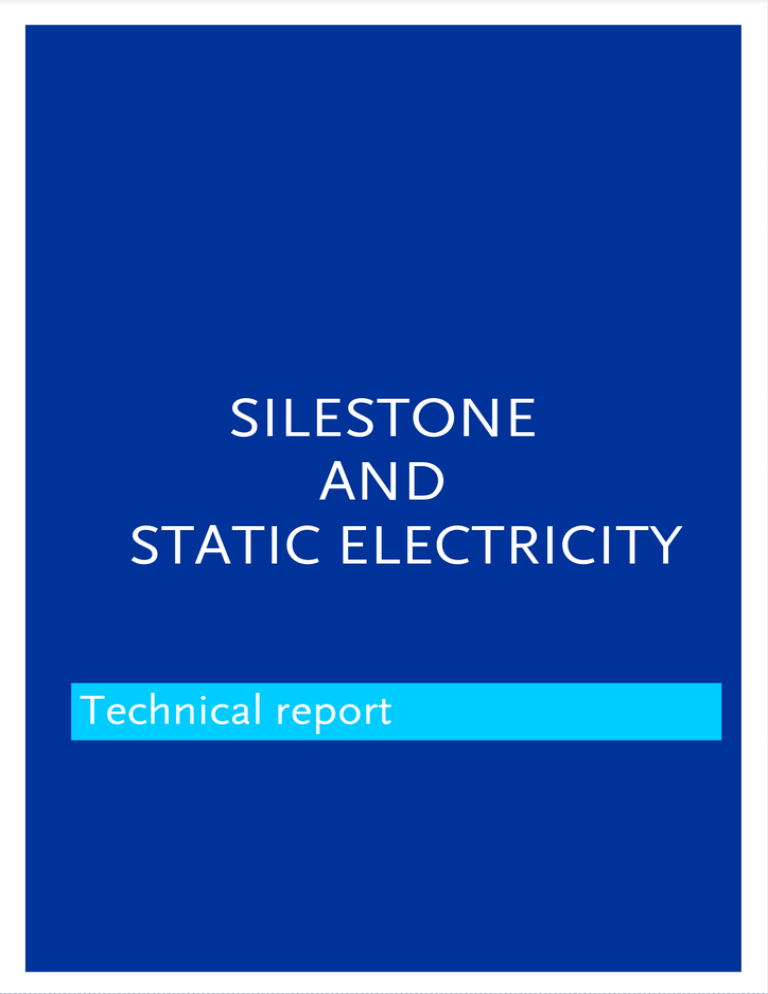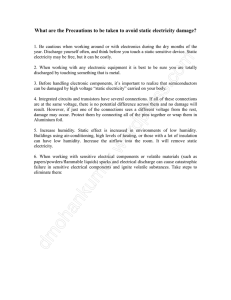silestone and static electricity
advertisement

SILESTONE AND STATIC ELECTRICITY Technical report Revision date: ------------------------Edition date : September 2009 STATIC ELECTRICITY TECHNICAL GUIDELINES TO REMOVE STATIC ELECTRICITY FROM SILESTONE FLOORING INTRODUCTION Silestone includes polyester resin in its composition so as to tie inorganic charge together. The polyester resin is endowed with high quality features with respect to mechanical resistance. However it does provide the material with some properties as an electrical insulator, which should be taken into consideration during the installation process. Static electricity can be generated by people walking across the floor. This electricity cannot be diverted to the floor surface when it is insulated but it will be discharged as soon as the person touches a conductive area. When this happens and if the total static electricity build up is very high, one can feel a slight but uncomfortable electric shock. The total static electricity generated by people will depend on some factors which are not possible to control, such as the soles of their shoes (leather, rubber) and even their physiologic characteristics (build, gender, age, etc.) These will clearly determine how sensitive a person is to electric shock. However there are some other factors which can be controlled, such as the surface area and the ambient humidity. With small surface areas that have high rates of ambient humidity, the total amount of static electricity never reaches a level which may cause electric shock. We will now describe some recommendations to be implemented in large areas, for instance offices, shopping malls etc. which have humidity rates lower than 60% due to the local climate and air-conditioning systems. The types of problems described in this document are common in materials used as flooring with insulating properties (vinyl and synthetic stone). SOLUTIONS Adverse affects resulting from static electricity can be diminished if we follow these steps. PRE- INSTALLATION These affects can be avoided with a correctly grounded system. This mainly consists in creating “ground paths” close enough to each other to ensure that people step on them when walking on the surface. Cosentino, S.A. 2 Revision date: ------------------------Edition date : September 2009 These “ground paths” are metallic bands placed on the surface and anchored into the cement used in constructing the floor, which should feature electrical properties such as insulating, discharging, and semiconductive materials, through which the grounded system of the building is connected. These can be matched up with the doors and the perimeter expansion joints to give them an aesthetic appearance. The aim in using these bands is to ensure people step on them before touching any metallic element. This is why there are particular places where the installation of these bands is especially advisable due to the expected contact with metal elements such as elevators, staircases and doors. POST INSTALLATION: Once the installation is completed the affects of electric shocks can be diminished by using detergents with anti-static properties. Cosentino specifically recommends the following products. - GD anti-static concentrated detergent for floor surfaces. Reference: DET10010. Company: ElectrostATEX - Anti-electrostatic detergent. Reference: 915.00910. Company: Soluciones Electrostáticas S.L. These two detergents are specially suited for Silestone floor laying and feature insulating properties which provide the surface with semi-conductor qualities. Applying these products can alleviate the problems which can arise from static electricity when the floor is in use. In addition these products can improve the slip-proof properties of Silestone flooring. As these two products are detergents they can be used to clean the installed floor without the need for additional detergents. Cosentino, S.A. 3 Revision date: ------------------------Edition date : September 2009 Instructions for use The properties for the use and concentration of these detergents have been especially optimized for Silestone flooring. In accordance with the environmental specifications listed below, the detergent must be diluted in water every time the floor surface is washed. In environmental conditions with a humidity rate less than 40%, we would recommend a concentration of 3% (v/v). I.e. 150ml of detergent for every 5 litres of water. In environmental conditions with a 40-60% humidity rate, we would recommend a concentration of 1.5% (v/v). I.e. 75 ml of the product for every 5 litres of water. The surface must be left to dry for at least 30 minutes before walking on it. The frequency of use will depend on the footfall. This is why the product should be applied at least twice a week in the event of a steady traffic flow. Finally, the surface should never be washed with products that do not have anti-static qualities. Cosentino, S.A. 4


